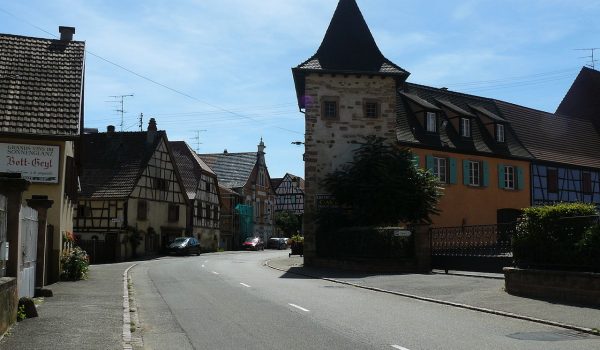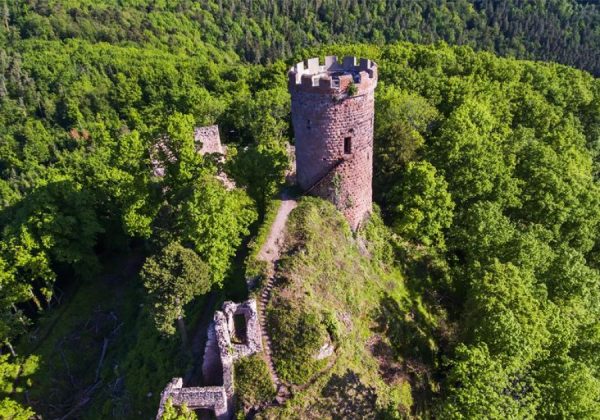First stop on your “tourism in Alsace” circuit, Beblenheim, a small wine-growing town, located at the foot of the Sonnenglanz hill (“Eclat du soleil”), is home to half-timbered houses dating from the 18th and 19th centuries, but some of which are from the 16th and 17th centuries.
The village also has a Gothic fountain from the end of the 15th century.


On the Wine Route, between vineyards and mountains, Ribeauvillé is one of the inevitable visits.
In the Middle Ages, the city was the seat of the Lordship of the Ribeaupierre family (hence the name of the city).
3 fortified castles majestically dominate the city and the surrounding hills. Accessible by a hiking trail, on the mountainside :
St-Ulrich Castle, (the oldest and most important of the three). Girsberg castle, Haut-Ribeaupierre castle, (the highest of the three).
Strolls in the heart of the historic center of Colmar
This list dedicated to tourism in Alsace is not exhaustive, we remain at your disposal to guide you according to your wishes in all your activities, cultural as sporting.
To date, it is one of the most visited fine arts museums in Colmar (180,000 visitors per year, before the start of the expansion work).
It has been managed for over 150 years by the Société Schongauer, a local law association with financial and administrative autonomy.
A reference place for tourism in Alsace, it benefits from the appellation Musée de France, controlled by the Museums of France service. Around the 13th century Gothic cloister, the 15th to 18th century collections are displayed. The most famous work, the Isenheim altarpiece, found its place in the old convent church.
Located in Colmar, is a museum dedicated to the sculptor Auguste Bartholdi. Labeled Musée de France, the building was labeled Maisons des Illustres by the Ministry of Culture and Communication in 2011.
In the courtyard is erected the bronze monumental group “The Great Supporters of the World”.
Neuf-Brisach is one of the ten towns created ex-nihilo by Vauban.
Its construction aims to compensate for the loss of the fortified town of Breisach-am-Rhein, located on the right bank of the Rhine.
Vauban has already worked in the region and in particular on the construction of the enclosure and the urban extension of Breisach-am-Rhein from 1664.
National museum located in Mulhouse (Haut-Rhin) which houses the largest collection of cars in the world.
More than 500 vehicles – including the famous Schlumpf collection of the Schlumpf Brothers (560 automobiles from 98 different brands).
Pioneers in the history of the automobile, (collection built between 1878 and 1918 including 430 classified as historical monuments, the most important collection of automobiles prior to 1910 with the Louwman museum in The Hague, an impressive collection of 14 Rolls Royces, and the largest Bugatti collection (over 120)) in the world.
The museum, which is housed in a former textile mill of the Schlumpf Brothers dating from 1880, classified as historical monuments, covers more than 20,000 m2.
French Museum located in Wingen-sur-Moder, Alsace, and dedicated to the master glassmaker and jeweler René Lalique and his successors.
Opened in July 2011, the Lalique museum exhibits around 650 pieces from its own collections, but also from company deposits, loans from Parisian museums or private collectors.
It is the only museum specifically dedicated to Lalique in Europe.
Located in the Rebberg district, on the edge of the Tannenwald forest, the zoo covers 25 hectares and features more than 900 animals of 170 species, as well as 3,500 varieties of plants.
It is a 12th century Alsatian fortified castle, profoundly altered in the 15th century and restored before the First World War under Guillaum II.
The castle is located in the Vosges mountains at an altitude of 757 m 12 km west of Sélestat from where it is visible. It is also 26 km north of Colmar from where it is also visible on a clear day and 55 km south of Strasbourg.
La Volerie des Aigles raises and presents endangered birds of prey to the public.
Eagles, hawks, vultures and other specimens evolve in the privileged setting of the castle and participate in the flight demonstrations organized daily.
The site is open from March to November. The visit lasts approximately 1 hour. There is free parking, a picnic area and a refreshment bar on site.
Among the unmissable vibrating places of tourism in Alsace, the Massif du Donon constitutes with its 1009 m of altitude the highest point of the lower Vosges, at the junction of the Alsatian and Lorraine provinces.
Since prehistoric times, because it is visible from afar, it has been attributed a sacred character that will never leave it.
Mont Sainte-Odile is a Vosges mountain, located in Ottrott in the Bas-Rhin department, culminating at an altitude of 767 meters.
It is surmounted by the Abbey of Hohenbourg, a convent overlooking the plain of Alsace, founded by Saint Odile, patron saint of Alsace, daughter of Duke Etichon.
A Mecca of Alsatian culture, this convent is a very popular pilgrimage site (1,300,000 visitors per year). On a clear day, the view extends to the Black Forest and the Bernese Alps. There are also the remains of an ancient wall, the “pagan wall”.
There are few places as enigmatic in the massif as this ridge of six kilometers in length. The ground is strewn with rocks and various inscriptions, many of which remain mysterious.
Another curiosity is the “pagan wall” which runs along its sides and whose origin remains unknown.
The summit is home to many plant and animal species, including the lynx which was reintroduced in the 20th century.
With alsaceavelo.fr discover more than 2,500 km of cycle routes adapted to all practices:
beginners or experienced, as a couple or as a family, can discover the Rhine plain, the vineyards and the Vosges mountains on marked and protected routes.
Unmissable tourist visit in Alsace, the cathedral founded in 1015 on the remains of a previous cathedral, was built from 1220 by the free city of Strasbourg, a rich merchant and financial republic, in the Gothic style and was practically completed in 1365 .
It has the particularity of having seen the space between the two towers filled in in 1388 and can be recognized by its unique bell tower, surmounted by a spire which was added to it in 1439.
For more than two centuries, it was the tallest building in the world with its one hundred and forty-two meters in height.
It remains the second highest cathedral in France after Rouen and the fifth in the world.
This 18th century building was built between 1732 and 1742 by the architect Robert de Cotte for the prince-bishop Armand Gaston Maximilien de Rohan to replace the previous episcopal palace.
It is built in the classic style, which became fashionable after the French conquest of Strasbourg.
First of all, the construction of this building, opposite the Notre-Dame cathedral, adorned with half-timberings, is one of the most richly decorated in the city and dates back to the year 1427.
Later, this work will not take its final aspect until 1589. Built by the famous cheese merchant Martin Braun, in this very particular Renaissance style, the ground floor is in stone and the upper floors in carved wood with glass bottom windows.
Obviously, depict sacred and secular scenes: the five senses, the four ages of life, faith, hope and charity and finally, the signs of the zodiac.
Moreover on the facade, several important characters of the story appear: César, Charlemagne, Hector and Godefroy de Bouillon.
Finally, on the pinion, we can still see the pulley which was used to raise the reserves to the attic.
La Petite France is a district in the historic center of Strasbourg where tourism in Alsace is essential. It has been a UNESCO World Heritage Site since 1988.
The district is bounded to the north by rue du Bain-aux-Plantes, place Benjamin-Zix and rue des Dentelles; to the east by the rue du Pont-Saint-Martin, the pont Saint-Martin and the footbridge of the Moulins; to the south by the Zorn mill canal; to the west by the covered bridges.
Guided tour of the Little Venice district in Colmar in an original way.
On board a flat-bottomed boat, discover all the charm of this authentic place.
Walk past the half-timbered houses and appreciate the serenity of the market garden district, where abundant vegetation abounds.
Europa-Park ist ein Themen- und Freizeitpark in Rust, Deutschland, zwischen den Städten Freiburg im Breisgau und Straßburg.

Like all trusted sites, gites-erable-alsace.com uses cookies in order to offer you secure browsing and appropriate content.